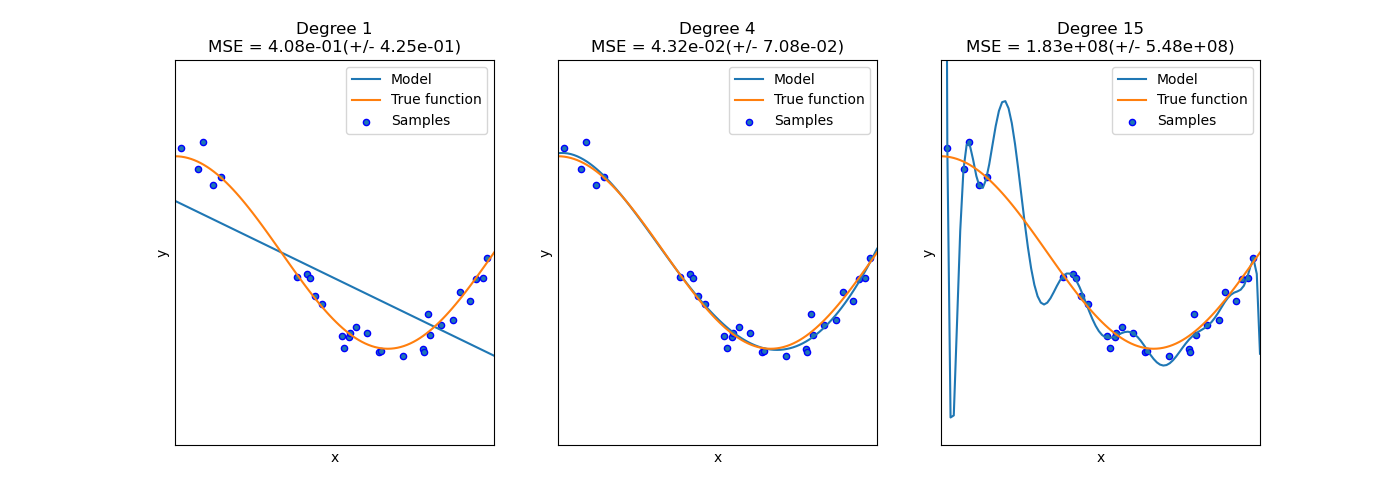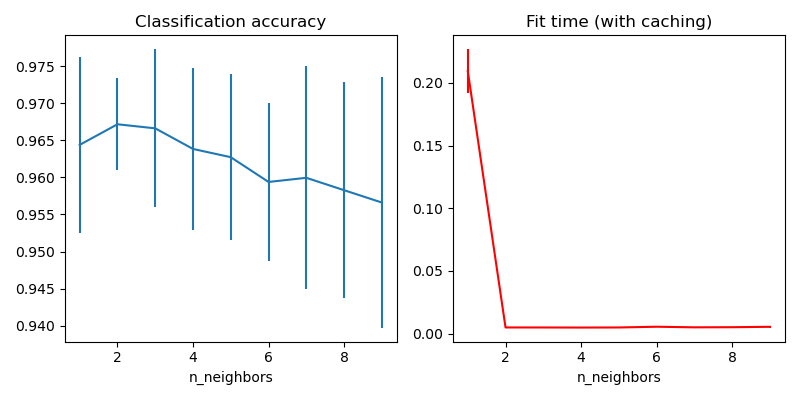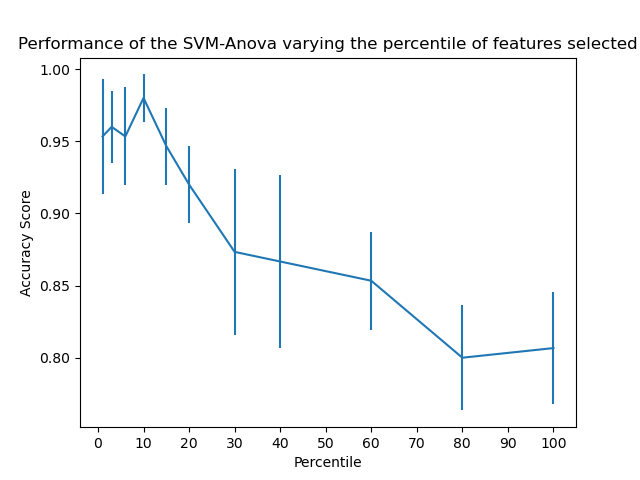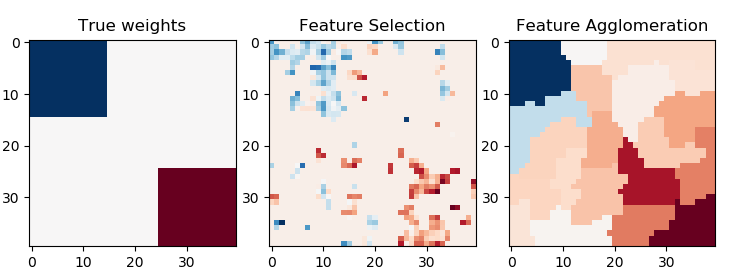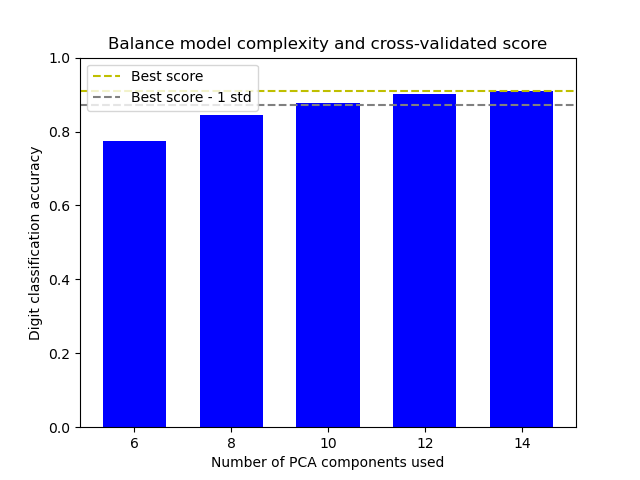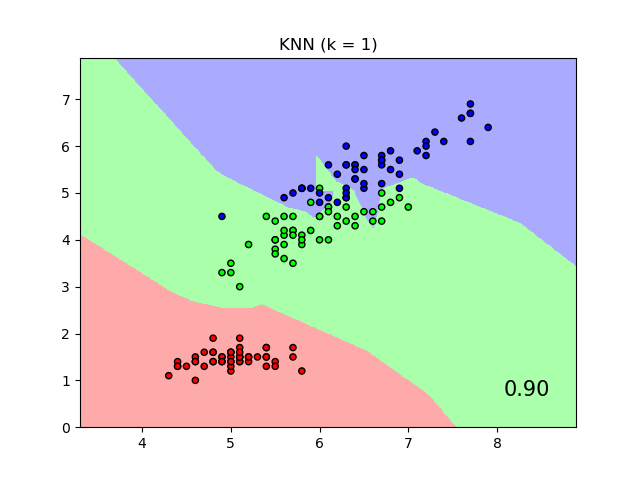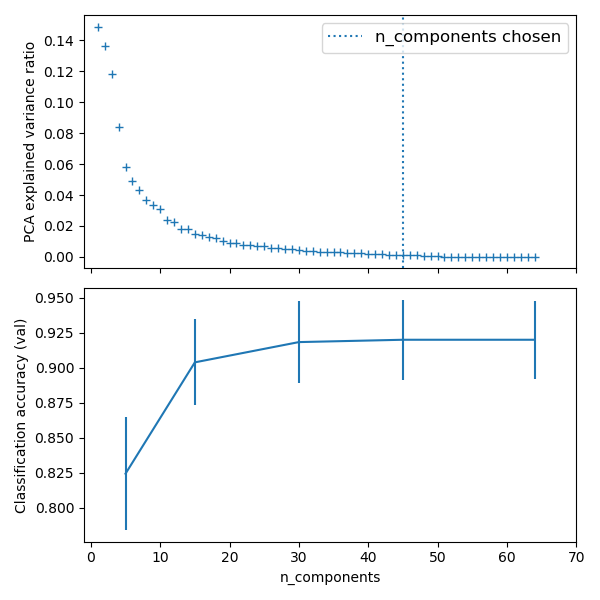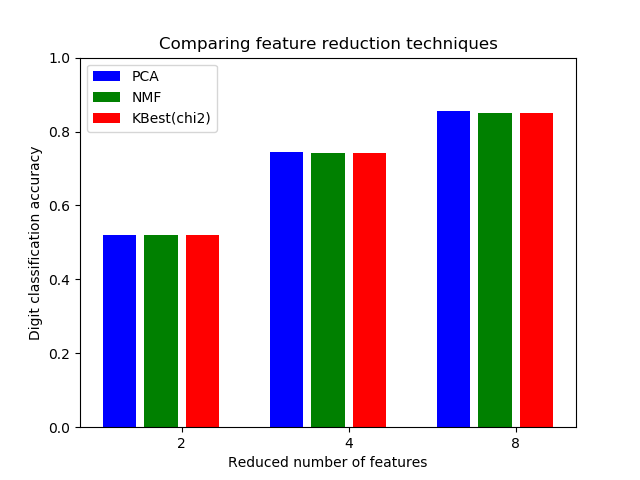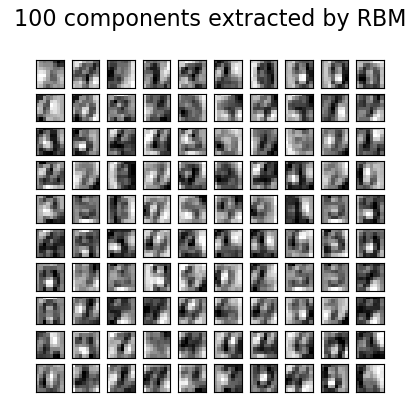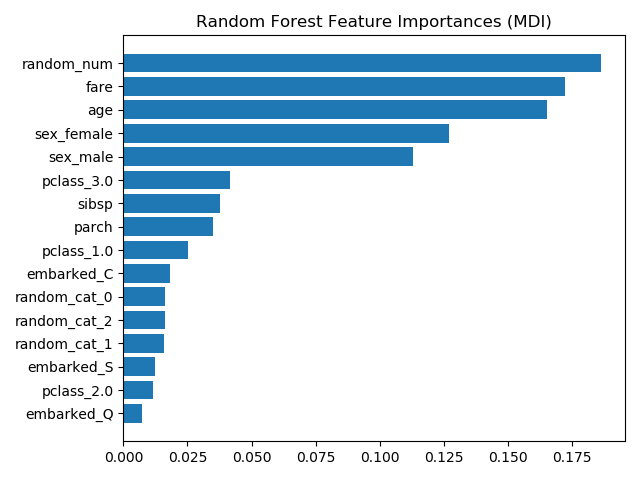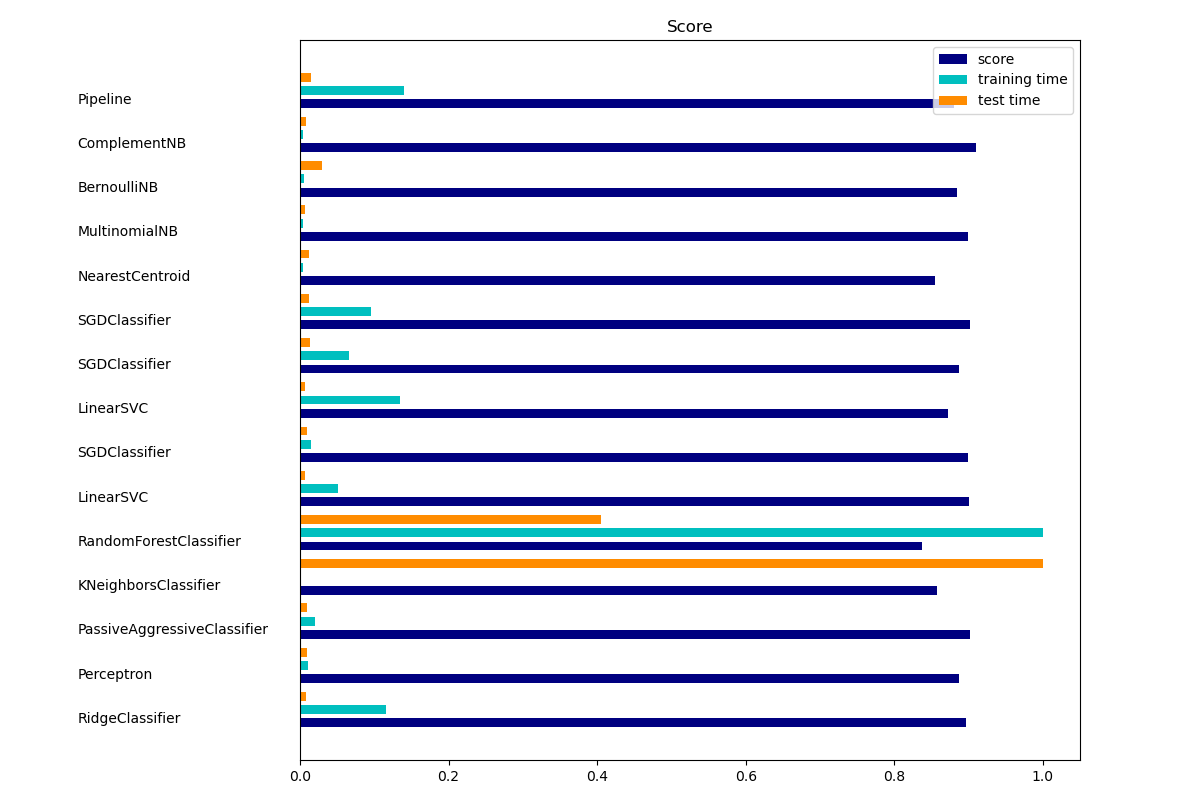sklearn.pipeline.Pipeline?
class sklearn.pipeline.Pipeline(steps, *, memory=None, verbose=False)
[源碼]
帶有最終估計器的轉換管道。
依次應用轉換列表和最終估計器。管道中間的steps必須是“transforms”(轉換器),也就是說,它們必須實現擬合和轉換方法。最終估計器只需實現擬合。使用memory參數可以緩存管道中的轉換器。
管道的目的是組裝幾個可以一起交叉驗證的steps,同時設置不同的參數。為此,它可以使用他們的名稱和以“__”分隔的參數名稱來設置各個steps的參數,如下所示。可以通過將參數的名稱設置為另一個估計器來完全替換一個step的估計器,也可以通過將其設置為“ passthrough”或None刪除轉換器。
在用戶指南中閱讀更多內容。
0.5版的新功能。
| 參數 | 說明 |
|---|---|
| steps | list (命名,轉換)元組(實現擬合/轉換)的列表,按照它們被鏈接的順序,最后一個對象是估計器。 |
| memory | str or object with the joblib.Memory interface, default=None 用于緩存擬合轉換的管道。默認情況下,不執行緩存。如果給定一個字符串,則它是緩存目錄的路徑。啟用緩存會觸發轉換器在擬合之前的克隆。因此,不能直接檢查提供給管道的轉換器實例。可以使用屬性 named_steps或steps檢查管道中的估計器。當擬合耗時時,緩存轉換器是有利的。 |
| verbose | bool, default=False 如果為True,則在擬合每個step時將打印經過的時間。 |
| 屬性 | 說明 |
|---|---|
| named_steps | Bunch類字典對象,具有以下屬性。只讀屬性,用于通過用戶給定名稱訪問任意step的參數。鍵是step的名稱,值是step的參數。 |
另見:
sklearn.pipeline.make_pipeline便利函數,簡化了管道建設。
示例
>>> from sklearn.svm import SVC
>>> from sklearn.preprocessing import StandardScaler
>>> from sklearn.datasets import make_classification
>>> from sklearn.model_selection import train_test_split
>>> from sklearn.pipeline import Pipeline
>>> X, y = make_classification(random_state=0)
>>> X_train, X_test, y_train, y_test = train_test_split(X, y,
... random_state=0)
>>> pipe = Pipeline([('scaler', StandardScaler()), ('svc', SVC())])
>>> # The pipeline can be used as any other estimator
>>> # and avoids leaking the test set into the train set
>>> pipe.fit(X_train, y_train)
Pipeline(steps=[('scaler', StandardScaler()), ('svc', SVC())])
>>> pipe.score(X_test, y_test)
0.88
方法
| 方法 | 說明 |
|---|---|
decision_function(X) |
應用transforms,和最后一個估計器的decision_function |
fit(X[, y]) |
擬合模型 |
fit_predict(X[, y]) |
在transforms后應用管道中最后一個step的fit_predict |
fit_transform(X[, y]) |
擬合模型并用最后一個估計器進行轉換 |
get_params([deep]) |
獲取這個估計器的參數 |
predict(X, **predict_params) |
將transforms應用于數據,并使用最后一個估計器進行預測 |
predict_log_proba(X) |
應用transforms,和最后一個估計器的predict_log_proba |
predict_proba(X) |
應用transforms,和最后一個估計器的predict_proba |
score(X[, y, sample_weight]) |
應用transforms,和最后一個估計器的score |
score_samples(X) |
應用transforms,和最后一個估計器的score_samples |
set_params(**kwargs) |
為這個估計器設置參數 |
__init__(steps, *, memory=None, verbose=False)
[源碼]
初始化self。詳情可參閱 type(self)的幫助。
decision_function(X)
[源碼]
應用transforms,和最后一個估計器的decision_function
| 參數 | 說明 |
|---|---|
| X | iterable 用于預測的數據。必須滿足管道第一個step的輸入要求。 |
| 返回值 | 說明 |
|---|---|
| y_score | array-like of shape (n_samples, n_classes) |
fit(X, y=None, **fit_params)
[源碼]
擬合模型
依次擬合所有轉換器變換并轉換數據,然后使用最后一個估計器擬合轉換后的數據。
| 參數 | 說明 |
|---|---|
| X | iterable 用于訓練的數據。必須滿足管道第一個step的輸入要求。 |
| y | iterable, default=None 訓練集標簽。必須滿足管道所有steps的標簽要求。 |
| **fit_params | dict of string -> object 每個step傳遞給 fit方法的參數,其中每個參數名稱都帶有前綴,比如用于步驟s的參數p有鍵s__p。 |
| 返回值 | 說明 |
|---|---|
| self | Pipeline 這個估計器 |
fit_predict(X, y=None, **fit_params)
[源碼]
在transforms后應用管道中最后一個step的fit_predict。
將管道的fit_transforms應用于數據,然后將管道中的最后一個估計器的fit_predict方法應用于數據。僅在最后一個估計器實現fit_predict時有效。
| 參數 | 說明 |
|---|---|
| X | iterable 用于訓練的數據。必須滿足管道第一個step的輸入要求。 |
| y | iterable, default=None 訓練集標簽。必須滿足管道所有steps的標簽要求。 |
| **fit_params | dict of string -> object 每個step傳遞給 fit方法的參數,其中每個參數名稱都帶有前綴,比如用于步驟s的參數p有鍵s__p。 |
| 返回值 | 說明 |
|---|---|
| y_pred | array-like |
fit_transform(X, y=None, **fit_params)
[源碼]
擬合模型并用最后一個估計器進行轉換
依次擬合所有轉換器并轉換數據,然后對帶有最后一個估計器的轉換后數據使用fit_transform。
| 參數 | 說明 |
|---|---|
| X | iterable 用于訓練的數據。必須滿足管道第一個step的輸入要求。 |
| y | iterable, default=None 訓練集標簽。必須滿足管道所有steps的標簽要求。 |
| **fit_params | dict of string -> object 每個step傳遞給 fit方法的參數,其中每個參數名稱都帶有前綴,比如用于步驟s的參數p有鍵s__p。 |
| 返回值 | 說明 |
|---|---|
| Xt | array-like of shape (n_samples, n_transformed_features) 轉換后的樣本 |
get_params(deep=True)
[源碼]
獲取這個估計器的參數
| 參數 | 說明 |
|---|---|
| deep | bool, default=True 如果為True,則將返回這個估計器的參數和所包含的估計器子對象。 |
| 返回值 | 說明 |
|---|---|
| params | mapping of string to any 參數名映射到其值 |
property inverse_transform
以相反順序應用逆變換。
管道中的所有估計器都必須支持inverse_transform。
| 參數 | 說明 |
|---|---|
| Xt | array-like of shape (n_samples, n_transformed_features) 數據樣本,其中 n_samples是樣本數量, n_features是特征數量。必須滿足管道最后一個step的inverse_transform方法的輸入要求 。 |
| 返回值 | 說明 |
|---|---|
| Xt | array-like of shape (n_samples, n_features) |
predict(X, **predict_params)
[源碼]
將transforms應用于數據,并使用最后一個估計器進行預測
| 參數 | 說明 |
|---|---|
| X | iterable 用于預測的數據。必須滿足管道第一個step的輸入要求。 |
| **predict_params | dict of string -> object 在管道中的所有轉換結束時調用 predict參數。請注意,雖然這可以用于從帶有return_std或return_cov的某些模型返回不確定性,但是由管道中的轉換生成的不確定性不會傳播到最后一個估計器。0.20版中的新功能。 |
| 返回值 | 說明 |
|---|---|
| y_pred | array-like |
predict_log_proba(X)
[源碼]
應用transforms,和最后一個估計器的predict_log_proba
| 參數 | 說明 |
|---|---|
| X | iterable 用于預測的數據。必須滿足管道第一個step的輸入要求。 |
| 返回值 | 說明 |
|---|---|
| y_score | array-like of shape (n_samples, n_classes) |
predict_proba(X)
[源碼]
應用transforms,和最后一個估計器的predict_proba
| 參數 | 說明 |
|---|---|
| X | iterable 用于預測的數據。必須滿足管道第一個step的輸入要求。 |
| 返回值 | 說明 |
|---|---|
| y_proba | array-like of shape (n_samples, n_classes) |
score(X, y=None, sample_weight=None)
[源碼]
應用transforms,和最后一個估計器的score
| 參數 | 說明 |
|---|---|
| X | iterable 用于預測的數據。必須滿足管道第一個step的輸入要求。 |
| y | iterable, default=None 用于計算準確率的標簽值。必須滿足管道所有steps的標簽要求。 |
| sample_weight | array-like, default=None 如果不是None,則將此參數作為 sample_weight關鍵字參數傳遞給最后一個估計器的score方法。 |
| 返回值 | 說明 |
|---|---|
| score | float |
score_samples(X)
[源碼]
應用transforms,和最后一個估計器的score_samples
| 參數 | 說明 |
|---|---|
| X | iterable 用于預測的數據。必須滿足管道第一個step的輸入要求。 |
| 返回值 | 說明 |
|---|---|
| y_score | ndarray of shape (n_samples,) |
set_params(**kwargs)
[源碼]
為這個估計器設置參數
有效的參數鍵可以用get_params()列出。
| 返回值 |
|---|
| self |
property transform
應用transforms,并使用最后一個估計器的transform
這在最后一個估計器為None的情況下也適用:應用之前所有的轉換器。
| 參數 | 說明 |
|---|---|
| X | iterable 用于轉換的數據。必須滿足管道第一個step的輸入要求。 |
| 返回值 | 說明 |
|---|---|
| Xt | array-like of shape (n_samples, n_transformed_features) |

